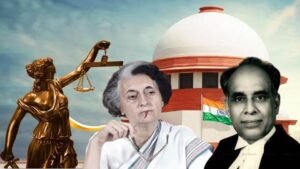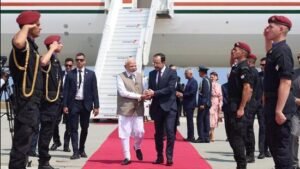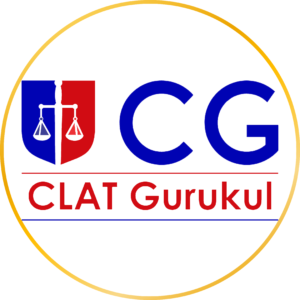
Why in News:
India and the United States have moved closer to finalising a long-awaited Bilateral Trade Agreement (BTA). The development comes just a day before the US was to impose reciprocal tariffs on Indian goods (April 2, 2025). This announcement gained traction due to US President Donald Trump’s statement that India would be dropping tariffs substantially.
This also came at a time when the US was intensifying pressure on trade partners, especially developing countries, to open up their markets and align policies in line with US business interests.
Introduction:
The announcement marks a pivotal moment in Indo-US economic relations. While strategic ties between the two democracies have flourished in recent years, trade has often been a point of contention. The recent convergence, facilitated through the intervention of the Prime Minister’s Office (PMO), signals a renewed effort to remove frictions and enhance economic cooperation.
Point-wise Summary:
- Finalisation of Terms of Reference (ToR):
- India finalised the Terms of Reference for a Bilateral Trade Agreement (BTA) with the United States.
- This step was taken just before the US was scheduled to impose reciprocal tariffs on Indian products (April 2, 2025).
- The ToR lays down the framework and objectives of the trade pact and is considered the first formal step towards negotiating a full-fledged agreement.
- PMO’s Role in Negotiations:
- The Prime Minister’s Office (PMO) played a crucial role in pushing the process forward.
- PMO’s intervention indicates the political will from the highest level to ensure the swift conclusion of the agreement.
- The finalisation of ToR over the weekend was termed a “significant development.”
- Trump’s Statement on Tariffs:
- US President Donald Trump publicly stated, “India is going to be dropping tariffs substantially.”
- This came as he highlighted the possibility of India reducing or removing tariffs on several American goods.
- Tariff Orders to Kick In on April 2:
- The US was set to implement retaliatory tariffs on Indian products starting April 2.
- These tariffs were in response to India’s previous trade practices, which the US considered discriminatory or protectionist.
- India’s Concession on US Goods:
- Reports suggest India may be planning to drop tariffs on specific goods from the US.
- This includes sectors where American companies had raised concerns over India’s trade barriers.
- USTR Report Flags Barriers in India:
- A report from the United States Trade Representative (USTR) titled “Foreign Trade Barriers 2025” flagged India’s:
- Internet shutdown policies,
- Restrictions on genetically modified (GM) foods,
- Other non-tariff barriers that restrict US companies.
- Gujarat’s New Pricing Policy on US Stents:
- Gujarat’s government approved a differential pricing system for stents approved by the US Food and Drug Administration (FDA).
- These stents will now cost ₹25,000 per unit — double the price of domestically approved stents (₹12,000).
- The decision impacts the Ayushman Bharat health insurance scheme, which uses these stents.
- Indian manufacturers raised objections, calling this policy discriminatory.
- Market Impact:
- The BSE Sensex fell sharply by 1,390.41 points, a 1.8% drop, ahead of the tariff imposition deadline.
- Market uncertainty and fears about global economic tensions weighed heavily on investor sentiment.
- The broader Nifty 50 also declined by 1.5% to 23,165.17.
Important Notes and Explanations (For CLAT Aspirants):
- Terms of Reference (ToR):
- A formal document that outlines the scope, objectives, roles, and responsibilities involved in the negotiation of a treaty or agreement.
- In trade deals, ToR sets the boundaries and vision of the pact before formal negotiations begin.
- Bilateral Trade Agreement (BTA):
- A BTA is a trade agreement between two countries to reduce or eliminate trade barriers such as tariffs, import quotas, and export restraints.
- BTAs aim to enhance trade and investment between the signatories.
- Tariffs:
- Tariffs are taxes imposed by a government on imports or exports.
- They are used to regulate trade, protect domestic industries, and generate revenue.
- Reciprocal Tariffs:
- These are retaliatory tariffs imposed by one country in response to tariffs imposed by another.
- In this context, the US intended to impose tariffs on Indian goods in response to perceived unfair trade practices.
- PMO’s Intervention:
- The Prime Minister’s Office stepping in indicates the strategic importance of the deal.
- It reflects political prioritisation of economic diplomacy.
- USTR (United States Trade Representative):
- A key agency responsible for developing and recommending US trade policy.
- Its annual Foreign Trade Barriers report identifies trade restrictions in various countries that affect US interests.
- Internet Shutdowns (as a Trade Barrier):
- Internet shutdowns, though often related to internal security, are viewed as barriers to digital trade and commerce by international businesses.
- USTR flagged India’s frequent internet shutdowns as a hindrance to doing business.
- GM Foods (Genetically Modified Foods):
- These are foods produced from organisms that have had changes introduced into their DNA using genetic engineering techniques.
- India’s restrictive policies on GM foods are seen by the US as trade barriers.
- US FDA-Approved Stents:
- Stents are medical devices used to treat narrowed or blocked blood vessels.
- FDA-approved stents are considered of high quality, and the Gujarat government’s move to price them at double the rate of Indian versions has raised controversy.
- Ayushman Bharat:
- A flagship health insurance scheme by the Government of India aimed at providing affordable healthcare to economically weaker sections.
- Market Reaction:
- Stock markets often react to uncertainty in international trade.
- The 1.8% fall in the Sensex signals investor anxiety over the possibility of a trade war or deteriorating Indo-US trade relations.
Relevance for CLAT 2026 Aspirants:
Legal Reasoning and Current Affairs:
- The issue ties into international trade law, intellectual property rights, healthcare regulations, and economic diplomacy.
- Students may be asked to evaluate the legality of tariffs, non-tariff barriers, and bilateral obligations under WTO rules.
Static + Dynamic GK Integration:
- Understanding how trade agreements function, and why international trade norms matter, is crucial for law students.
- Concepts like tariffs, ToR, BTA, and regulatory barriers can appear in both Legal Reasoning and GK sections.
Essay Writing/PI Topics (For Law Schools):
- Topics like “Are tariffs justified in a globalised economy?”, “India-US trade relations: A bumpy ride”, or “Should healthcare pricing favour foreign or domestic companies?” can be explored in essays and interviews.
Conclusion:
The finalisation of trade deal terms between India and the US represents a significant shift in global diplomacy and trade policy. As India seeks to balance its strategic autonomy with economic integration, the decisions made now will shape the trajectory of its foreign and domestic economic policy. The announcement not only reflects India’s growing importance on the world trade stage but also highlights the complexities involved in balancing domestic interests with global obligations.






